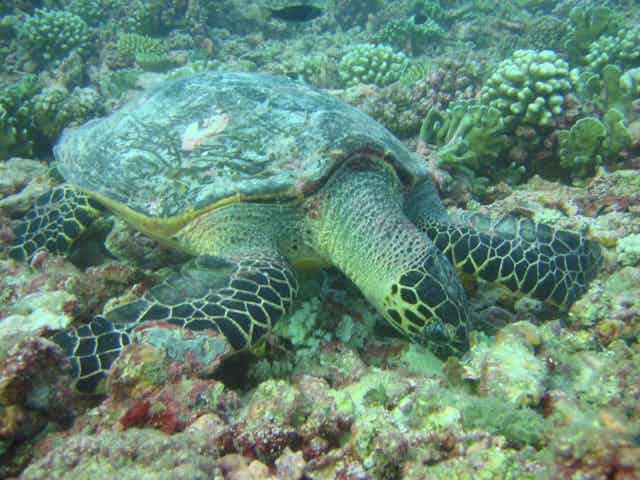Hawksbill turtles are critically endangered, they are found in every ocean and are the most tropical of sea turtles. Adult hawksbills have long been considered to have a close association with shallow (less than 15 metres depth) seas where coral reefs thrive.
But new research my colleagues and I conducted reveals for the first time that hawksbill turtles feed at reef sites much deeper than previously thought.
Young hawksbills drift in currents during their pelagic (open water) phase of their development before they move to benthic (sea bed) habitats. Hawksbills are usually seen foraging in coral reefs where their diet is predominantly sponges. They also feed on a variety of algae, corallimorphs (coral-like anemones), tunicates and more.
To study their feeding habits in more detail, my team at Swansea University used high-accuracy global positioning system (GPS) satellite tags to track 22 adult female hawksbills from their nesting site on Diego Garcia in the Chagos archipelago in the Indian Ocean to their foraging grounds.
Three of the tags included a pressure transducer that was programmed to record depth every five minutes and relay the measurement to the satellite system every time the turtle surfaced. This gave us information about the whereabouts of the turtles and how deep they were diving to feed as they swam.

We predicted that hawksbills tracked in our study would probably migrate to shallow coral reefs around the seven atolls of the Chagos archipelago. Many studies have shown the pristine nature of these reefs and we have previously observed hawksbills frequently foraging in reef habitats there.
But, surprisingly, all turtles migrated to deep, remote banks and submerged reefs in the archipelago, remaining at these deep sites for more than 6,000 combined days of tracking. By looking at nautical charts for the turtle locations, we could see that the foraging habitat was located at more than 30 metres depth.
More than 183,000 depth measurements relayed from the tags on three turtles showed that average depths were between 35 metres and 40 metres. Most dives reached depths between 30 metres and 60 metres. That’s much deeper than we expected.

Crucial for conservation
The coral reefs located at depths of between 30 metres and 150 metres below the waves are known as mesophotic (or low light) ecosystems. Now, knowing that these habitats are so crucial for critically endangered sea turtles suggests that the marine life deep down on the seabed is much richer – with more nutritious food for turtles to eat – than previously thought.
We’d expect to find an abundance of colourful sponges and other invertebrate prey items such as soft corals that make up a big portion of the hawksbills’ diet. Our finding adds to the growing evidence that submerged banks at these mesophotic depths might be home to a diverse community of life, including sponges and seagrass that are key foods for green turtles that also breed and forage in the western Indian Ocean.
Mesophotic ecosystems cover a vast area so they should be a significant part of conservation considerations. We estimated that submerged banks (at depths of 30 to 60 metres) in the western Indian Ocean extend across over 55,000 km² - around three times the size of a small country such as Wales.
Scientific understanding of mesophotic ecosystems is very poor, partly because they are difficult to explore. They are usually remote and far from land, plus the depths are often beyond the limit of routine scientific scuba diving.
There’s huge scope for more fascinating research to investigate the ecology of these misunderstood marine habitats. Recent studies have suggested rich biodiversity and abundant fish, corals and sponges live at depths over 30 metres.
Reef refuges
With the pressures of climate change and warming seas, mesophotic reefs could be a refuge for corals and sponges that normally live in shallow coral reefs. For example, coral cover in Caribbean mesophotic reefs (30 to 40 metres depth) remained constant during hurricanes, bleaching and disease events in 2017 to 2019 when coral cover declined in shallow- and mid-water depths. That demonstrates the importance of these mesophotic reefs as a reproductive refuge for corals.
Our study findings highlight that submerged banks and mesophotic depths are important foraging grounds for critically endangered marine animals such as turtles and may support a rich array of marine life. While the mesophotic reefs used by foraging hawksbills in our study lie within one of the world’s largest marine protected areas, with protection from industrial fishing, there are ongoing negotiations for future conservation management of this region.
These submerged banks in the Chagos archipelago, and probably others around the world, should be key areas for conservation focus. The resilience of marine ecosystems, and all that lives within them, may rely on the health of these deeper, uncharted habitats, especially in the face of climate change.

Don’t have time to read about climate change as much as you’d like?
Get a weekly roundup in your inbox instead. Every Wednesday, The Conversation’s environment editor writes Imagine, a short email that goes a little deeper into just one climate issue. Join the 30,000+ readers who’ve subscribed so far.


